![]()
Menu:
Orcadian Trout Menu
This basic information sheet is written as an introduction to the feeding habits of the native brown trout which inhabit the lochs of our Islands. The subject of entomology is fascinating and, as one gains more experience and knowledge, the pursuit of matching the exact hatch can become an obsession.
My own thoughts are that once preferred fish food-items have been identified then a reasonably close imitation, if one is to hand, can work fine.
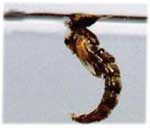
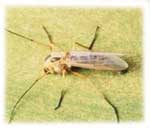
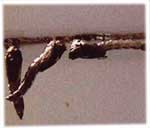
I can honestly say that, as my interest in the aquatic and terrestrial insects which trout feed on improved and developed, my catch rate increased dramatically. However, mastering the science of entomology will not necessarily make an ultimate fish catcher, as so many other angling skills must come together to create success. Knowing the limitations of your equipment, knowledge of the water, a stealthy approach, presentation and above all the ability to become a thinking angler, coupled with an entomological knowledge, will set the novice on the road to success.
What we have listed below are the most common and important insects and other life-forms, which the local or visiting angler will encounter on the various lochs and some fly patterns regularly used to imitate the natural. There are five main groups of insect, which are the most important to the fish.
Flatwinged flies (Diptera sp.), Upwinged flies (Ephemeroptera sp.), Flies with roof shaped wings (Trichoptera sp.) Hardwinged flies (Plecoptera sp.), and Fauna, which will include the other food-forms not included in the above families, such as Beetles, Fish, Daphnia, etc. -:-
Chironomids [commonly referred to as Midge] (Diptera) This food source is probably the most important of all as fish will feed on this insect at every stage of development, the worm like larva, the pupa stage and the adult all form a major part of the trout's diet thoughout the year. There are many varieties and the main colours are: black, grey, olive, dark green & apple green. Cold weather species can be very small and are generally black. Hatches of all species on all of Orkneys Lochs Patterns to try: Black Pennel,Hutch's Pennel, Hoppers, Diawl Bach, Zulus,Palmers, Peacock herl midge, most small immitave patterns the right colour.
Heather Flies (Ditpera). A very occasionally important terrestrial insect. Related to Hawthorn Flies and equally well liked by trout. Hatch from heather and get blown to water. Poor fliers and will settle on water surface at first chance. Black body with bright reddish-orange thighs. This is the natural that the original Ke-He was designed to replicate (I'm 90% certain). Most often found on Swannay, but very occasionally on Hundland or Boardhouse. Will not be seen or hatch every year. Patterns: Bibio Hopper, Black Zulu, Bibio, Black Ke-He
N on Identified Diptera. There is an insect which has an aquatic larval stage, the adult form closely resembling a housefly, which is regularly seen on Swannay in the first half of the season. Hatches of this fly can cause good rises. These flies can be seen on almost every water in Orkney but the best hatches are on the loch mentioned. Slightly smaller than a HouseFly and slightly browner. Patterns: Fiery-Brown or Dark Hare's Ear dry patterns
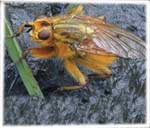

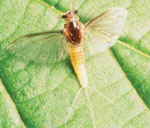
Cow Dung Fly (Diptera). Our most important terrestrial. Males larger & golden olive, females smaller & greyish olive green. Males out & about throughout fishing season, females proliferate in late summer. The quantity of females hatching in a short period of time makes the trout very interested in them, but trout will pick off the males in the early season when they get a chance (good areas for this are Kirkness & Tenston). The adults sit very high on the water and are, occasionally, very hard to imitate as they drift across the surface in front of the breeze. Patterns: Hedgehogs, Palmers, Hoppers, Hare's Ear patterns, Palmered March Brown, Muddlers, Dry Flies assorted.
Seaweed Fly (Diptera). Occasionally important semi-terrestrial on Stenness. Larvae feed on rotting weed in the margins and adults drift offshore ahead of breeze, causing good rises. Very like Cow Dung Fly in shape & size (perhaps a touch bigger) but more like a House Fly in colour. Mid-summer best. Patterns: Palmered Coch, Yellow Lamas.
Olives (Ephemeroptera). Our main species is Pond Olive, but with a smattering of Claret & Sepia Duns (Swannay). Hatches - late May & again in September. Nymphs are very fast swimmers and don't spend much time in surface film whilst hatching. Fish rising in an olive hatch are most likely taking ascending nymphs. Best hatches Harray & Boardhouse. Aquatic until adulthood. Patterns: Hare's Ear patterns, Pheasant Tail. In bright conditions orange hackled, gold bodied patterns (e.g. Kingfisher Butcher & Dunkeld) can be very useful.
Caenis [commonly known as Angler's Curse] (Ephemeroptera). Small ephemerid species closely related to Olives. Two species in Orkney - one with a black abdomen and one with a creamy-white abdomen. The latter most common. Massive hatches on most lochs even Sin mud deposits in deepish water. Nymphs crawl on the bottom waiting to hatch. Hatch mid-Summer until lateAugust, generally in calm, mild weather. Fish eat all stages of insect, but probably take the dead spinner most often. Hard to replicate and trout will feed on little else when hatches are on. Patterns: Shipman's Buzzer in various colours and Hare's Ear dries, but accurate casting most important
Sedges [sometimes referred to as Caddis Flies] (Trichoptera). The darker they are the more acceptable to trout - Black species on Harray, dark cinnamon's on Boardhouse, Hundland & Swannay. Pale species seem to be ignored.. Aquatic stages until adulthood. Larvae are probably more important food items than adults. Patterns: Stick Fly, Dark Loch Ordie, Connemara Black, Ke-He, Green Peter, Claret Bumble and appropriately coloured Sedgehogs and Hoppers for dry patterns.
Alder Fly (Megaloptera) Hatches on Hundland every year. Looks like a good-sized sedge with heavily veined transparent wings. Nymphs are very active swimmers but, prior to hatching, swim ashore and the Adults, when hatched, hide under stones. The larvae & nymphs should be important food items in Orkney lochs because they are elsewhere. May & June are the best times for a hatch. Patterns: Stick Fly, Worm Fly and Ombudsman to represent nymphs
Stonefly [sometimes referred to as Needle Flies](Plecoptera). All stages, bar adult, fully aquatic but, like the Alder, adults gets off the water quick and hide under stones. Vast number of species, most common in Swannay & Hundland. Plecoptera species all have a low tolerance for pollution. Nymphs are important food but, as they crawl and don't swim, not as important as they could be. Many colours from jet black to very bright green. Patterns: Stick Flies, Olive & Dark Dabblers, Black Mini-Lures.
Crane Flies [sometimes referred to as Daddies, etc.] (Diptera). Daddy Long Legs/crane flies are chironimids, but not midge, of course. Again, many species, but the most popular & prolific are the big browns, which hatch mid-summer onwards. Some species aquatic, but big browns are fully terrestrial. Patterns: Most leggy type Daddy patterns.

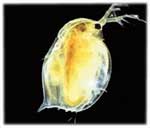
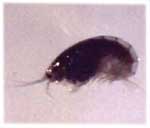
Shrimp (Crustaceans). Totally aquatic and found in all the lochs. Fish concentrate on them in early spring - mid-Summer, when the (shrimp) are spawning, and free-swimming. At other times shrimp hide away. Shrimps may be a variety of colours from slate grey - golden olive, but never orange (This is the affect of digestive juices in trout gut). May have a red spot halfway down the body - this is a parasite. Patterns: Green Peter, Soldier Palmer, Peacock Palmer and almost anything at times. Possum Shrimp (Crustaceans). Aquatic & semi-marine. Will not survive long in pure fresh water, so only found in Stenness & Harray. (Usually South of Ess Holmes but big flushes of Stenness water can push then further). Patterns:Silver Invicta, Pearly Wickhams.
Snails (Molluscs). Aquatic & found everywhere. Snails will float when mating but our species don't seem to have massive floatations. Trout usually pick them off the stones, making snail feeding fish hard to catch (head down amongst stones). Pea mussels are very important in shallow water areas (e.g. Stoneyhill), and trout seem to like them a lot. Patterns: Palmered Coch & Coch-y-bonddhu
Corixa (Corixa). Almost totally aquatic insect, although adults can fly (if ponds dry out). Vitally important in shallow, rich environments, such as Clumly, Sanday lochs, etc. Usually to be found hanging around weed beds. Fish tend to take them as they swim to the surface, where they pick up a bubble of air, and dive with it. Regional colour variations (I've seen bright green jobs in Isbister loch), but generally buffish brown. Patterns: Silver Invicta & Hare's Ear Muddlers (in small sizes)
Daphnia (Crustaceans) Aquatic water fleas. Colour depends upon algae colour which the individual is eating, generally light green - transparent. Everywhere (bar Stenness, I suppose). Live in open water, usually beside weed clumps. Patterns: Impossible to imitate, but fluorescent greens & oranges in fast stripped flies at the correct depth will generally do something.
Sticklebacks (Pisces) Will survive in totally fresh or full marine environment. Found everywhere. Fish prefer fry, but will take adults occasionally. Fry are very translucent & silvery, and tend to shoal up, feeding on daphnia and similar. Generally found in very shallow water, near stones or weed. Trout tend to feed on Sticklebacks during late evening - early morning, and in shallow water. Patterns: Difficult to imitate at times, but Silver Invicta, Alexandra, Mallard & Claret and even Palmered March Brown will work enough to satisfy.
Beetles (various species) - Hundreds of species, some very important, others less so. Aquatic diving beetles can be important in some waters (Clumly, etc.) but the best one, from an angling perspective, are those which are terrestrial and fall on the water. Small brown & black beetles, in numbers, struggling in thesurface film can cause massive rises, which can perplex anglers who cannot spot the cause. More important with each passing year as climate and agricultural changes effect species range. Pattern: Small dries, e.g. Black Blob, Black & Claret, Fiery Brown emerger.
Eels (Pisces) Found everywhere and important source of food for big fish. Generally found in mud or under stones. Even big eels (up to 24" long) will get eaten by big trout. Very important food source in Harray & Stenness. Elver runs must exist and though I've found them in sea trout never in browns - strange! Patterns: There aren't any - anyone trying to cast a 24" eel imitation is liable to end up with a broken rod!
Leeches (Annelids) Fully aquatic creature, related to earthworms, of a variety of species. Everywhere, most important to trout in Swannay. Colours - varying shades of green & brown. Bottom dwellers, non-swimmers. Seem most important in early months of season until July. Patterns: Mini-Lures of appropriate colour fished at depth
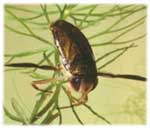
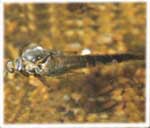
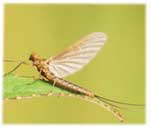
Jim Adams